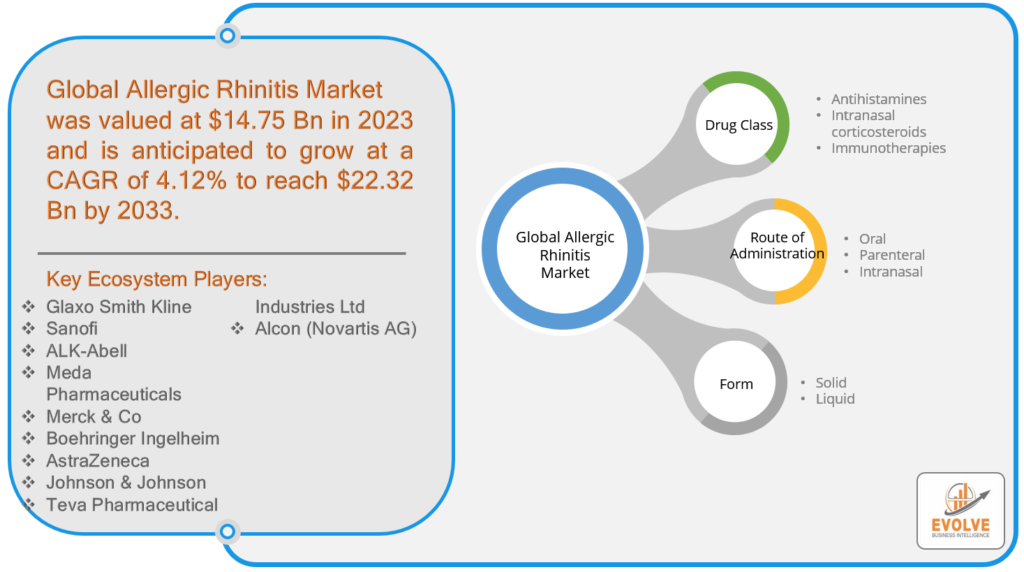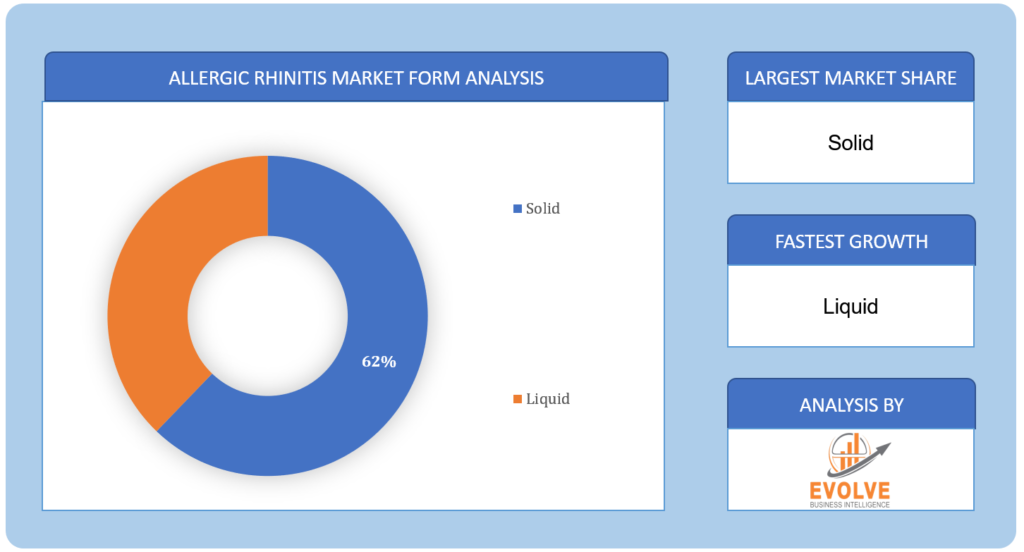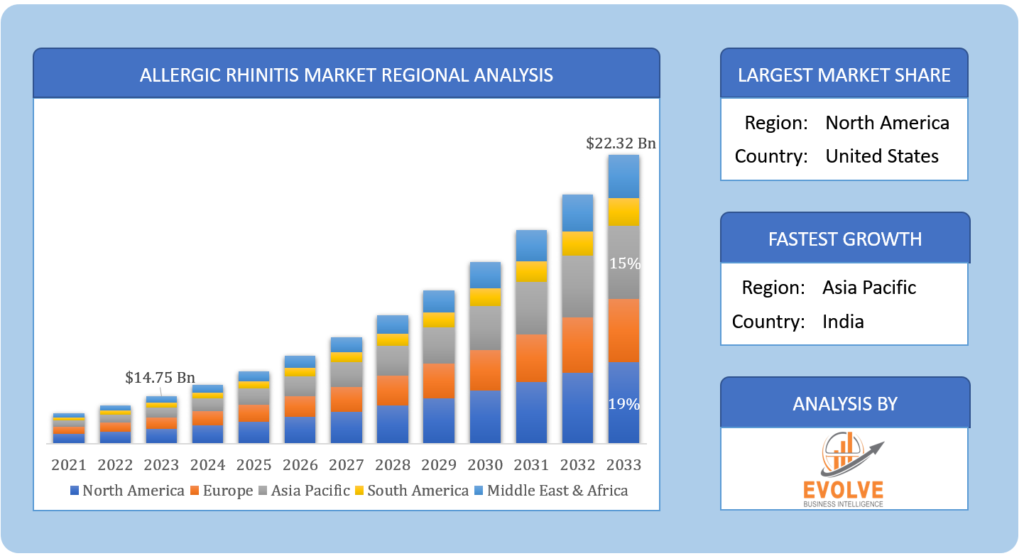Allergic Rhinitis Market Analysis and Global Forecast 2023-2033
$ 1,390.00 – $ 5,520.00Price range: $ 1,390.00 through $ 5,520.00
Allergic Rhinitis Market Research Report: Information By Drug Class (Antihistamines, Intranasal cortico steroids, Immuno therapies), By Route of Administration (Oral, Parenteral, Intranasal), By Form (Solid, Liquid), and By Region — Forecast till 2033.
Press Release: https://evolvebi.com/desiccant-air-breathers-market-is-estimated-to-record-a-cagr-of-around-5-58-during-the-forecast-period/
Allergic Rhinitis Market Overview
The Global Allergic Rhinitis Market Size is expected to reach USD 22.32 Billion by 2033. The global Allergic Rhinitis industry size accounted for USD 14.75 billion in 2023 and is expected to expand at a compound annual growth rate (CAGR) of 4.12% from 2023 to 2033.Allergic rhinitis is a chronic condition that can be seasonal or perennial, depending on the type of allergen and individual sensitivity. Seasonal allergic rhinitis is usually triggered by airborne allergens that are prevalent during specific times of the year, such as tree pollen in the spring, grass pollen in the summer, and weed pollen in the fall. Perennial allergic rhinitis, on the other hand, can occur year-round and is often triggered by indoor allergens, such as dust mites, pet dander, and mold spores. Treatment for allergic rhinitis may include allergen avoidance, medication such as antihistamines, decongestants, nasal cortico steroids, and immune therapy (allergy shots) for severe cases. It’s important to consult a healthcare professional for an accurate diagnosis and appropriate treatment plan tailored to individual needs.
COVID-19 Impact Analysis
The COVID-19 pandemic has had a multi-faceted impact on the Allergic Rhinitis market, with changes in patient behavior, disruptions in healthcare services, economic challenges, and shifts in research and development efforts. The full extent of the impact may continue to evolve as the pandemic situation changes and further research is conducted. It is important to consult with healthcare professionals and stay updated with the latest information and guidelines for the management of Allergic Rhinitis during the pandemic.
Allergic Rhinitis Market Dynamics
 The major factors that have impacted the growth of Allergic Rhinitis are as follows:
The major factors that have impacted the growth of Allergic Rhinitis are as follows:
Drivers:
- Growing awareness and diagnosis of allergic
Awareness about allergic rhinitis has been raised through various channels, including public health campaigns, educational initiatives by healthcare organizations, and increased media coverage. Patients and healthcare providers are now better informed about the common symptoms of allergic rhinitis, such as sneezing, itching, nasal congestion, and a runny nose, which prompts them to seek medical attention for a proper diagnosis.Early diagnosis of allergic rhinitis allows for timely initiation of treatment, which can help in managing symptoms and preventing complications. It also helps in identifying triggers and implementing appropriate allergen avoidance strategies. As a result, there is a higher demand for medications and other treatment options to effectively manage allergic rhinitis, which drives the growth of the Allergic Rhinitis market.
Restraint:
- Side effects and safety concerns
Some of the medications used for allergic rhinitis, such as nasal corticosteroids and antihistamines, may have side effects such as drowsiness, dryness of the mouth or nose, and other adverse effects. This may limit their use in certain patient populations, such as children, Old Person individuals, or those with specific health conditions. Safety concerns associated with the long-term use of medications may also impact patient compliance and adherence to treatment regimens, which could be a restraint for the market.
Opportunity:
- Increasing adoption of immuno therapy
Immuno therapy, such as subcutaneous or sublingual allergen immuno therapy, has shown promising results in managing allergic rhinitis by addressing the underlying immune response to allergens. With increasing research and clinical evidence supporting the safety and efficacy of immuno therapy, there is an opportunity for wider adoption of immuno therapy as a long-term treatment option for allergic rhinitis. This can drive the growth of the market and provide additional treatment options for patients.
Allergic Rhinitis Segment Overview
Based on the Drug Class, the market is segmented based on Antihistamines, Intranasal cortico steroids, and Immuno therapies. During the projection period, the Antihistaminessegmentis expected to hold the largest market share.Antihistamines are commonly used for the treatment of Allergic Rhinitis, which is a condition characterized by inflammation of the nasal passages due to an allergic reaction. Antihistamines work by blocking the action of histamine, a chemical released by the immune system in response to allergens, thus relieving symptoms such as sneezing, itching, and a runny nose.
By Route of Administration
Based on the Route of Administration, the market has been divided into Oral, Parental, and Intranasal. The Oral segment is expected to hold the largest market share.Oral medications, including antihistamines and other classes of drugs, are commonly used for the treatment of Allergic Rhinitis. Oral antihistamines are available over-the-counter (OTC) or with a prescription, and they are typically used for mild to moderate symptoms of Allergic Rhinitis, such as sneezing, itching, and a runny nose. They work by blocking the action of histamine, a chemical released by the immune system in response to allergens.
By Form
Based on Form, the market has been divided into Solid and Liquid.The Solid segment is expected to hold the largest market share.Solid dosage forms, including oral tablets and capsules, are commonly used for the treatment of Allergic Rhinitis. Oral medications, such as antihistamines, decongestants, and nasal cortico steroids, are available in solid dosage forms and are typically used for mild to moderate symptoms of Allergic Rhinitis, including sneezing, itching, and a runny nose.
Global Allergic Rhinitis Market Share, by Segmentation
Based on region, the global MHealth market has been divided into North America, Europe, Asia-Pacific, and the Rest of the World. North America is projected to dominate the use of the market followed by the Asia-Pacific and Europe regions.
North America Market
North America holds a significant share of the global allergic rhinitis market. Allergic rhinitis, commonly known as hay fever, is a condition characterized by inflammation of the nasal passages due to an immune response triggered by allergens such as pollen, dust mites, pet dander, and mold spores. In North America, the prevalence of allergic rhinitis is relatively high, with a large number of people suffering from seasonal or perennial allergies. The region has a well-established healthcare infrastructure and advanced diagnostic and treatment options, which contribute to the dominance of North America in the allergic rhinitis market.
Asia-Pacific Market
The Asia-Pacific region is projected to be a prominent growth market for the allergic rhinitis market. Allergic rhinitis, commonly known as hay fever, is a condition characterized by inflammation of the nasal passages due to an immune response triggered by allergens such as pollen, dust mites, pet dander, and mold spores. In recent years, there has been an increasing awareness of allergic rhinitis in the Asia-Pacific region, leading to a higher demand for diagnosis and treatment options. Rapid urbanization, changing lifestyles, and environmental factors such as increasing pollution levels and exposure to allergens are contributing to the rising prevalence of allergic rhinitis in the region. Furthermore, the growing middle-class population with higher disposable incomes and improved access to healthcare services are driving the demand for allergic rhinitis medications and treatments in the Asia-Pacific region. Increasing investments in healthcare infrastructure andthe rising adoption of advanced diagnostic and treatment technologies are also supporting the growth of the allergic rhinitis market in the region.
Competitive Landscape
The market comprises tier-1, tier-2, and local players. With their wide product portfolios, tier-1 and tier-2 players have a global reach. Since their strategic innovations and broad regional presence, companies such as Glaxo Smith Kline,Merck & Co, Johnson & Johnson, and Sanofi lead the global Allergic Rhinitis business. To increase their market position and attract a wide consumer base, the businesses are employing various strategies, such as growth, product releases, and alliances.
Prominent Players:
- Glaxo Smith Kline
- Sanofi
- ALK-Abell
- Meda Pharmaceuticals
- Merck & Co
- Boehringer Ingelheim
- AstraZeneca
- Johnson & Johnson
- Teva Pharmaceutical Industries Ltd
- Alcon (Novartis AG)
Key Development:
November 2022: Alcon announced the acquisition of Aerie Pharmaceuticals, Inc. This acquisition will assist Alcon in strengthening its ophthalmic medicines portfolio, which already includes several commercial products and others in the development stage.
September 2022: Glenmark Pharmaceuticals’ Ryaltris nasal spray. The utilization of this cutting-edge therapeutic approach is employed to treat severe seasonal allergic rhinitis as well as other eye problems. Through its subsidiaries Glenmark Specialty SA and Bausch Health Companies Inc., the permission is secured.
March 2021: ALK announced that the FDA had approved the use of short ragweed pollen allergen extract for the treatment of patients with short ragweed pollen-induced allergic rhinitis who are 5 to 65 years old.
Scope of the Report
Global Allergic Rhinitis Market, by Drug Class
- Antihistamines
- Intranasal corticosteroids
- Immunotherapies
Global Allergic Rhinitis Market, by Route of Administration
- Oral
- Parenteral
- Intranasal
Global Allergic Rhinitis Market, by Form
- Solid
- Liquid
Global Allergic Rhinitis Market, by Region
- North America
- US
- Canada
- Mexico
- Europe
- UK
- Germany
- France
- Italy
- Spain
- Benelux
- Nordic
- Rest of Europe
- Asia Pacific
- China
- Japan
- South Korea
- Indonesia
- Austalia
- Malaysia
- India
- Rest of Asia Pacific
- South America
- Brazil
- Argentina
- Rest of SouthAmerica
- Middle East &Africa
- Saudi Arabia
- UAE
- Egypt
- SouthAfrica
- Rest of Middle East & Africa
| Parameters | Indicators |
|---|---|
Market Size | 2033: USD22.32Billion |
CAGR | 4.12% CAGR (2023-2033) |
Base Year | 2022 |
Forecast Period | 2023 to 2033 |
Historical Data | 2021 |
Report Coverage | Revenue Forecast, Competitive Landscape, Growth Factors, and Trends |
Key Segmentations | Drug Class,Route of Administration,Form |
Geographies Covered | North America, Europe, Asia-Pacific, Latin America, Middle East, Africa |
Key Players | GlaxoSmithKline, Sanofi, ALK-Abell, Meda Pharmaceuticals, Merck & Co., Boehringer Ingelheim, AstraZeneca, Johnson & Johnson, Teva Pharmaceutical Industries Ltd., Alcon (Novartis AG) |
Key Market Opportunities | Increasing adoption of immunotherapy |
Key Market Drivers | Growing awareness and diagnosis of allergic rhinitis |
REPORT CONTENT BRIEF:
- High-level analysis of the current and future Allergic Rhinitis market trends and opportunities
- Detailed analysis of current market drivers, restraining factors, and opportunities in the future
- Allergic Rhinitis market historical market size for the year 2021, and forecast from 2023 to 2033
- Allergic Rhinitis market share analysis at each product level
- Competitor analysis with a detailed insight into its product segment, financial strength, and strategies adopted.
- Identifies key strategies adopted including product launches and developments, mergers and acquisitions, joint ventures, collaborations, and partnerships as well as funding taken and investment done, among others.
- To identify and understand the various factors involved in the global Allergic Rhinitis market affected by the pandemic
- To provide a detailed insight into the major companies operating in the market. The profiling will include the financial health of the company’s past 2-3 years with segmental and regional revenue breakup, product offering, recent developments, SWOT analysis, and key strategies.
Press Release

Global Pharmaceutical Manufacturing Market to Reach $1.38 Trillion by 2035 with 7.35% CAGR, New Research Shows

The Global Mammography Market Is Estimated To Record a CAGR of Around 10.29% During The Forecast Period

Glue Stick Market to Reach USD 2.35 Billion by 2034

Podiatry Service Market to Reach USD 11.88 Billion by 2034

Microfluidics Technology Market to Reach USD 32.58 Billion by 2034

Ferric Chloride Market to Reach USD 10.65 Billion by 2034

Family Practice EMR Software Market to Reach USD 21.52 Billion by 2034

Electric Hairbrush Market to Reach USD 15.95 Billion by 2034

Daily Bamboo Products Market to Reach USD 143.52 Billion by 2034

Cross-border E-commerce Logistics Market to Reach USD 112.65 Billion by 2034

Hydrogen Fuel Cell Market Analysis and Global Forecast 2023-2035
Hydrogen Fuel Cell Market Research Report: Information by Type (Proton Exchange Membrane Fuel cells, Phosphoric Acid Fuel Cells, Solid Oxide Fuel Cells, Molten Carbonate Fuel Cells, Others), By Application (Stationary, Transportation, Portable), By End-Use (Fuel Cell Vehicles, Utilities, Defense), and by Region — Forecast till 2033
Page: 116

HoReCa Market Analysis and Global Forecast 2023-2035
HoReCa Market Research Report: Information By Service Type (Hotels, Restaurants, Cafés, Pubs), By Category (Single Outlet, HoReCa Chain), and by Region — Forecast till 2035
Page: 116

Medical Nitrile Gloves Market Analysis and Global Forecast 2023-2033
Medical Nitrile Gloves Market Research Report: Information By Type (Powdered gloves, Non-powdered gloves), By Usage (Disposable, Reusable), By Application (Medical & Healthcare, Food Industry, Cleaning Industry, Others), By End Use (Ambulatory Surgery Centers, Diagnostic Centers, Rehabilitation Centers), and by Region — Forecast till 2033
Page: 116

Bidets Market Analysis and US Forecast 2023-2033
US Bidets Market By Type (Ceramic Bidets, Over the Rim Bidets, Handheld Bidets, Others), By Category (Electronics, Manual), By Distribution Channel (Store-Based, Non-Store-Based), By End Use (Residential, Commercial) and By Geography – COVID-19 Impact Analysis, Post COVID Analysis, Opportunities, Trends and Forecast from 2021 to 2028
Report Code: EB_LS_1279 | Page: 59 | Published Date: April 2022

Semiconductor Rectifiers Market Analysis and Global Forecast 2023-2033
Semiconductor Rectifiers Market Research Report: Information By Type (Half Wave, Full Wave), By Industry Vertical (Communication, Consumer Electronics, Automotive, Manufacturing), and by Region — Forecast till 2033
Page: 165
Frequently Asked Questions (FAQ)
What is the study period of this market?
The study period of the global Allergic Rhinitis market is 2022- 2033
What is the growth rate of the global Allergic Rhinitis market?
The global Allergic Rhinitis market is growing at a CAGR of ~4.12% over the next 10 years
Which region has the highest growth rate in the market of Allergic Rhinitis?
Asia Pacific is expected to register the highest CAGR during 2023-2033
Which region has the largest share of the global Allergic Rhinitis market?
North America holds the largest share in 2022
Who are the key players in the global Allergic Rhinitis market?
GlaxoSmithKline, Sanofi, ALK-Abell, Meda Pharmaceuticals, Merck & Co., Boehringer Ingelheim, AstraZeneca, Johnson & Johnson, Teva Pharmaceutical Industries Ltd., Alcon (Novartis AG)are the major companies operating in the market.
Do you offer Post Sale Support?
Yes, we offer 16 hours of analyst support to solve the queries
Do you sell particular sections of a report?
Yes, we provide regional as well as country-level reports. Other than this we also provide a sectional report. Please get in contact with our sales representatives.
Table of content
Table of Content
CHAPTER 1. Executive Summary
CHAPTER 2. Scope of the Study
2.1. Market Definition
2.2. Market Scope & Segmentation
2.2.1. Objective of Report
CHAPTER 3. Evolve BI Methodology
3.1. Data Collection & Validation Approach
3.2. Market Size Estimation and Forecast
CHAPTER 4. Exclusive Analysis
4.1. Market Opportunity Score
4.1.1. Drug Class Segement – Market Opportunity Score
4.1.2. Route of Administration Segment – Market Opportunity Score
4.1.3. Form Segment – Market Opportunity Score
4.2. Key Market Influencing Indicators
CHAPTER 5. Market Insights and Trends
5.1. Value Chain Analysis
5.1.1. Raw Material
5.1.2. Manufacturing Process
5.1.3. Distribution Channel
5.1.4. End User
5.2. Porter’s Five Forces Analysis
5.2.1. Bargaining Power of Buyers
5.2.2. Bargaining Power of Suppliers
5.2.3. Threat of New Entrant
5.2.4. Threat of Substitute
5.2.5. Industry Rivalry
5.3. COVID-19 Impact and Post COVID Scenario on Allergic Rhinitis Market
5.3.1. Impact of COVID-19
5.3.2. Government Support and Industry Revival Policies
5.3.3. Measures Taken by Companies to Mitigate Negative Impact
5.3.4. Post COVID Trend
CHAPTER 6. MArket Dynamics
6.1. Introduction
6.2. Drivers
6.2.1. Driver 1
6.2.2. Driver 2
6.2.3. Driver 3
6.3. Restraints
6.3.1. Restraint 1
6.3.2. Restraint 2
6.4. Opportunity
6.4.1. Opportunity 1
CHAPTER 7. Global Allergic Rhinitis Market, By Drug Class
7.1. Introduction
7.1.1. Antihistamines
7.1.2. Intranasal corticosteroids
7.1.3. Immunotherapies
CHAPTER 8. Global Allergic Rhinitis Market, By Route of Administration
8.1. Introduction
8.1.1. Oral
8.1.2. Parenteral
8.1.3. Intranasal
CHAPTER 9. Global Allergic Rhinitis Market, By Form
9.1. Introduction
9.1.1. Solid
9.1.2. Liquid
CHAPTER 10. Global Allergic Rhinitis Market, By Region
10.1. Introduction
10.2. NORTH AMERICA
10.2.1. North America: Market Size and Forecast, By Country, 2021 – 2033 ($ Million)
10.2.2. North America: Market Size and Forecast, By Drug Class, 2021 – 2033 ($ Million)
10.2.3. North America: Market Size and Forecast, By Route of Administration, 2021 – 2033 ($ Million)
10.2.4. North America: Market Size and Forecast, By Form, 2021 – 2033 ($ Million)
10.2.5. US
10.2.5.1. US: Market Size and Forecast, By Drug Class, 2021 – 2033 ($ Million)
10.2.5.2. US: Market Size and Forecast, By Route of Administration, 2021 – 2033 ($ Million)
10.2.5.3. US: Market Size and Forecast, By Form, 2021 – 2033 ($ Million)
10.2.6. CANADA
10.2.6.1. Canada: Market Size and Forecast, By Drug Class, 2021 – 2033 ($ Million)
10.2.6.2. Canada: Market Size and Forecast, By Route of Administration, 2021 – 2033 ($ Million)
10.2.6.3. Canada: Market Size and Forecast, By Form, 2021 – 2033 ($ Million)
10.2.7. MEXICO
10.2.7.1. Mexico: Market Size and Forecast, By Drug Class, 2021 – 2033 ($ Million)
10.2.7.2. Mexico: Market Size and Forecast, By Route of Administration, 2021 – 2033 ($ Million)
10.2.7.3. Mexico: Market Size and Forecast, By Form, 2021 – 2033 ($ Million)
10.3. Europe
10.3.1. Europe: Market Size and Forecast, By Country, 2021 – 2033 ($ Million)
10.3.2. Europe: Market Size and Forecast, By Drug Class, 2021 – 2033 ($ Million)
10.3.3. Europe: Market Size and Forecast, By Route of Administration, 2021 – 2033 ($ Million)
10.3.4. Europe: Market Size and Forecast, By Form, 2021 – 2033 ($ Million)
10.3.5. U.K.
10.3.5.1. U.K.: Market Size and Forecast, By Drug Class, 2021 – 2033 ($ Million)
10.3.5.2. U.K.: Market Size and Forecast, By Route of Administration, 2021 – 2033 ($ Million)
10.3.5.3. U.K.: Market Size and Forecast, By Form, 2021 – 2033 ($ Million)
10.3.6. GERMANY
10.3.6.1. Germany: Market Size and Forecast, By Drug Class, 2021 – 2033 ($ Million)
10.3.6.2. Germany: Market Size and Forecast, By Route of Administration, 2021 – 2033 ($ Million)
10.3.6.3. Germany: Market Size and Forecast, By Form, 2021 – 2033 ($ Million)
10.3.7. FRANCE
10.3.7.1. France: Market Size and Forecast, By Drug Class, 2021 – 2033 ($ Million)
10.3.7.2. France: Market Size and Forecast, By Route of Administration, 2021 – 2033 ($ Million)
10.3.7.3. France: Market Size and Forecast, By Form, 2021 – 2033 ($ Million)
10.3.8. ITALY
10.3.8.1. Italy: Market Size and Forecast, By Drug Class, 2021 – 2033 ($ Million)
10.3.8.2. Italy: Market Size and Forecast, By Route of Administration, 2021 – 2033 ($ Million)
10.3.8.3. Italy: Market Size and Forecast, By Form, 2021 – 2033 ($ Million)
10.3.9. SPAIN
10.3.9.1. Spain: Market Size and Forecast, By Drug Class, 2021 – 2033 ($ Million)
10.3.9.2. Spain: Market Size and Forecast, By Route of Administration, 2021 – 2033 ($ Million)
10.3.9.3. Spain: Market Size and Forecast, By Form, 2021 – 2033 ($ Million)
10.3.10. BENELUX
10.3.10.1. BeNeLux: Market Size and Forecast, By Drug Class, 2021 – 2033 ($ Million)
10.3.10.2. BeNeLux: Market Size and Forecast, By Route of Administration, 2021 – 2033 ($ Million)
10.3.10.3. BeNeLux: Market Size and Forecast, By Form, 2021 – 2033 ($ Million)
10.3.11. RUSSIA
10.3.11.1. Russia: Market Size and Forecast, By Drug Class, 2021 – 2033 ($ Million)
10.3.11.2. Russia: Market Size and Forecast, By Route of Administration, 2021 – 2033 ($ Million)
10.3.11.3. Russia: Market Size and Forecast, By Form, 2021 – 2033 ($ Million)
10.3.12. REST OF EUROPE
10.3.12.1. Rest of Europe: Market Size and Forecast, By Drug Class, 2021 – 2033 ($ Million)
10.3.12.2. Rest of Europe: Market Size and Forecast, By Route of Administration, 2021 – 2033 ($ Million)
10.3.12.3. Rest of Europe: Market Size and Forecast, By Form, 2021 – 2033 ($ Million)
10.4. Asia Pacific
10.4.1. Asia Pacific: Market Size and Forecast, By Country, 2021 – 2033 ($ Million)
10.4.2. Asia Pacific: Market Size and Forecast, By Drug Class, 2021 – 2033 ($ Million)
10.4.3. Asia Pacific: Market Size and Forecast, By Route of Administration, 2021 – 2033 ($ Million)
10.4.4. Asia Pacific: Market Size and Forecast, By Form, 2021 – 2033 ($ Million)
10.4.5. CHINA
10.4.5.1. China: Market Size and Forecast, By Drug Class, 2021 – 2033 ($ Million)
10.4.5.2. China: Market Size and Forecast, By Route of Administration, 2021 – 2033 ($ Million)
10.4.5.3. China: Market Size and Forecast, By Form, 2021 – 2033 ($ Million)
10.4.6. JAPAN
10.4.6.1. Japan: Market Size and Forecast, By Drug Class, 2021 – 2033 ($ Million)
10.4.6.2. Japan: Market Size and Forecast, By Route of Administration, 2021 – 2033 ($ Million)
10.4.6.3. Japan: Market Size and Forecast, By Form, 2021 – 2033 ($ Million)
10.4.7. INDIA
10.4.7.1. India: Market Size and Forecast, By Drug Class, 2021 – 2033 ($ Million)
10.4.7.2. India: Market Size and Forecast, By Route of Administration, 2021 – 2033 ($ Million)
10.4.7.3. India: Market Size and Forecast, By Form, 2021 – 2033 ($ Million)
10.4.8. SOUTH KOREA
10.4.8.1. South Korea: Market Size and Forecast, By Drug Class, 2021 – 2033 ($ Million)
10.4.8.2. South Korea: Market Size and Forecast, By Route of Administration, 2021 – 2033 ($ Million)
10.4.8.3. South Korea: Market Size and Forecast, By Form, 2021 – 2033 ($ Million)
10.4.9. THAILAND
10.4.9.1. Thailand: Market Size and Forecast, By Drug Class, 2021 – 2033 ($ Million)
10.4.9.2. Thailand: Market Size and Forecast, By Route of Administration, 2021 – 2033 ($ Million)
10.4.9.3. Thailand: Market Size and Forecast, By Form, 2021 – 2033 ($ Million)
10.4.10. INDONESIA
10.4.10.1. Indonesia: Market Size and Forecast, By Drug Class, 2021 – 2033 ($ Million)
10.4.10.2. Indonesia: Market Size and Forecast, By Route of Administration, 2021 – 2033 ($ Million)
10.4.10.3. Indonesia: Market Size and Forecast, By Form, 2021 – 2033 ($ Million)
10.4.11. MALAYSIA
10.4.11.1. Malaysia: Market Size and Forecast, By Drug Class, 2021 – 2033 ($ Million)
10.4.11.2. Malaysia: Market Size and Forecast, By Route of Administration, 2021 – 2033 ($ Million)
10.4.11.3. Malaysia: Market Size and Forecast, By Form, 2021 – 2033 ($ Million)
10.4.12. AUSTRALIA
10.4.12.1. Australia: Market Size and Forecast, By Drug Class, 2021 – 2033 ($ Million)
10.4.12.2. Australia: Market Size and Forecast, By Route of Administration, 2021 – 2033 ($ Million)
10.4.12.3. Australia: Market Size and Forecast, By Form, 2021 – 2033 ($ Million)
10.4.13. REST FO ASIA PACIFIC
10.4.13.1. Rest fo Asia Pacific: Market Size and Forecast, By Drug Class, 2021 – 2033 ($ Million)
10.4.13.2. Rest fo Asia Pacific: Market Size and Forecast, By Route of Administration, 2021 – 2033 ($ Million)
10.4.13.3. Rest fo Asia Pacific: Market Size and Forecast, By Form, 2021 – 2033 ($ Million)
10.5. South America
10.5.1. South America: Market Size and Forecast, By Country, 2021 – 2033 ($ Million)
10.5.2. South America: Market Size and Forecast, By Drug Class, 2021 – 2033 ($ Million)
10.5.3. South America: Market Size and Forecast, By Route of Administration, 2021 – 2033 ($ Million)
10.5.4. South America: Market Size and Forecast, By Form, 2021 – 2033 ($ Million)
10.5.5. BRAZIL
10.5.5.1. Brazil: Market Size and Forecast, By Drug Class, 2021 – 2033 ($ Million)
10.5.5.2. Brazil: Market Size and Forecast, By Route of Administration, 2021 – 2033 ($ Million)
10.5.5.3. Brazil: Market Size and Forecast, By Form, 2021 – 2033 ($ Million)
10.5.6. ARGENTINA
10.5.6.1. Argentina: Market Size and Forecast, By Drug Class, 2021 – 2033 ($ Million)
10.5.6.2. Argentina: Market Size and Forecast, By Route of Administration, 2021 – 2033 ($ Million)
10.5.6.3. Argentina: Market Size and Forecast, By Form, 2021 – 2033 ($ Million)
10.5.7. REST OF SOUTH AMERICA
10.5.7.1. Rest of South America: Market Size and Forecast, By Drug Class, 2021 – 2033 ($ Million)
10.5.7.2. Rest of South America: Market Size and Forecast, By Route of Administration, 2021 – 2033 ($ Million)
10.5.7.3. Rest of South America: Market Size and Forecast, By Form, 2021 – 2033 ($ Million)
10.6. Middle East & Africa
10.6.1. Middle East & Africa: Market Size and Forecast, By Country, 2021 – 2033 ($ Million)
10.6.2. Middle East & Africa: Market Size and Forecast, By Drug Class, 2021 – 2033 ($ Million)
10.6.3. Middle East & Africa: Market Size and Forecast, By Route of Administration, 2021 – 2033 ($ Million)
10.6.4. Middle East & Africa: Market Size and Forecast, By Form, 2021 – 2033 ($ Million)
10.6.5. SAUDI ARABIA
10.6.5.1. Saudi Arabia: Market Size and Forecast, By Drug Class, 2021 – 2033 ($ Million)
10.6.5.2. Saudi Arabia: Market Size and Forecast, By Route of Administration, 2021 – 2033 ($ Million)
10.6.5.3. Saudi Arabia: Market Size and Forecast, By Form, 2021 – 2033 ($ Million)
10.6.6. UAE
10.6.6.1. UAE: Market Size and Forecast, By Drug Class, 2021 – 2033 ($ Million)
10.6.6.2. UAE: Market Size and Forecast, By Route of Administration, 2021 – 2033 ($ Million)
10.6.6.3. UAE: Market Size and Forecast, By Form, 2021 – 2033 ($ Million)
10.6.7. EGYPT
10.6.7.1. Egypt: Market Size and Forecast, By Drug Class, 2021 – 2033 ($ Million)
10.6.7.2. Egypt: Market Size and Forecast, By Route of Administration, 2021 – 2033 ($ Million)
10.6.7.3. Egypt: Market Size and Forecast, By Form, 2021 – 2033 ($ Million)
10.6.8. SOUTH AFRICA
10.6.8.1. South Africa: Market Size and Forecast, By Drug Class, 2021 – 2033 ($ Million)
10.6.8.2. South Africa: Market Size and Forecast, By Route of Administration, 2021 – 2033 ($ Million)
10.6.8.3. South Africa: Market Size and Forecast, By Form, 2021 – 2033 ($ Million)
10.6.9. REST OF MIDDLE EAST & AFRICA
10.6.9.1. Rest of Middle East & Africa: Market Size and Forecast, By Drug Class, 2021 – 2033 ($ Million)
10.6.9.2. Rest of Middle East & Africa: Market Size and Forecast, By Route of Administration, 2021 – 2033 ($ Million)
10.6.9.3. Rest of Middle East & Africa: Market Size and Forecast, By Form, 2021 – 2033 ($ Million)
CHAPTER 12. Competitive Landscape
12.1. Competitior Benchmarking 2023
12.2. Market Share Analysis
12.3. Key Developments Analysis By Top 5 Companies
12.4. Market Share Acquisition Strategies: Analysis of Key Approaches Employed by Top Players
CHAPTER 13. Company Profiles
13.1. GlaxoSmithKline
13.1.1. Business Overview
13.1.2. Financial Analysis
13.1.2.1. Business Segment Revenue, 2020, 2021, 2022, $ Million
13.1.2.2. Geographic Revenue Mix, 2022 (% Share)
13.1.3. Drug Class Portfolio
13.1.4. Recent Development and Strategies Adopted
13.1.5. SWOT Analysis
13.2. Sanofi
13.3. ALK-Abell
13.4. Meda Pharmaceuticals
13.5. Merck & Co
13.6. Boehringer Ingelheim
13.7. AstraZeneca
13.8. Johnson & Johnson
13.9. Teva Pharmaceutical Industries Ltd
13.10.Alcon (Novartis AG)
Connect to Analyst
Research Methodology













